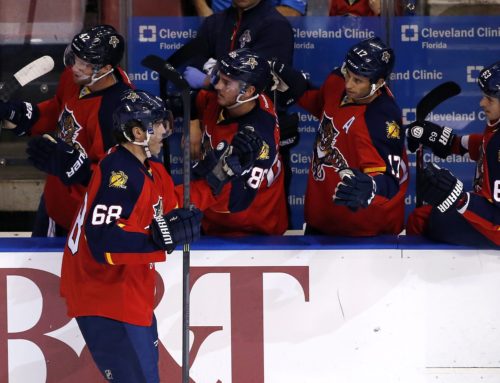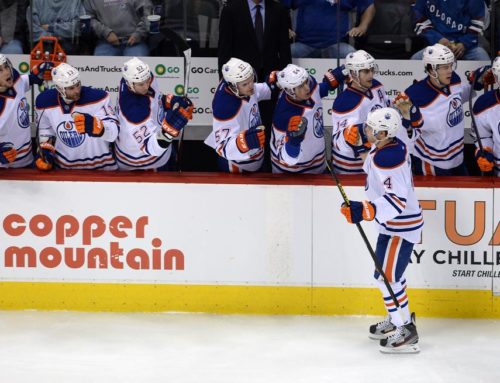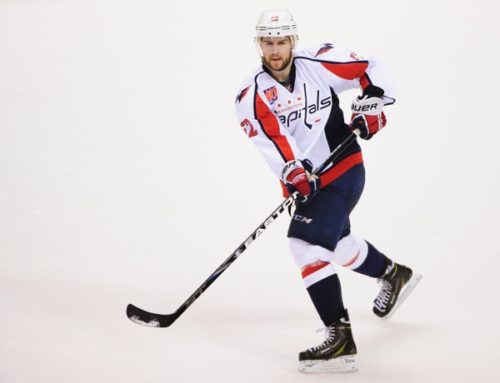
What can we expect scoring-wise from KHLers like Evgeny Kuznetsov, Jiri Sekac, Leo Komarov, Petri Kontiola, and Jori Lehtera?
There’s no need to get out the Tarot cards and the tea leaves, because hockey analytics can actually shed some interesting light on this topic. Given that the KHL is the league most comparable to the NHL in quality, its data is surprisingly useful in projecting NHL scoring. It’s almost reasonably as effective as having actual NHL data on which to base a player’s projection.
How is this done? With NHL equivalencies (NHLe), which are easily one of my favourite modern analytic innovations. Three years ago on ESPN, for example, I used it to project Jaromir Jagr‘s scoring upon coming back to the NHL. I’ve also used it with the other European leagues, the AHL, the U.S. Colleges, and even the Canadian juniors. Over the years I’ve refined the process by adding age curves, separating goals and assists, accounting for ice time, and much more.
The methodology is explained in far more detail in Chapter 14 of Hockey Abstract, and all the data is available on the Hockey Abstract website, so I won’t go into too much detail here. Simply put, we take all the players who previously moved from the KHL to the NHL, and figure out how much of their scoring that they retained after the jump. Then when we want to figure out how many points someone will score in the NHL, we can just multiply their KHL scoring rate by that translation factor.
Here’s a table of the latest translation factors, fresh from Chapter 14. For each league, the translation factor is broken down by what it was prior to and after the 2005 lockout, when a lot of NHL players were competing in various professional leagues, and NHL-ready youngsters were remaining in juniors and colleges for an additional season. The translation factor for the KHL since the lockout, for example, is 0.78, so in its very simplest form, a player’s scoring rate in the NHL can be estimated by multiplying his KHL scoring rate by that number.

Of course, I love seeing this type of data on a chart, an approach that is even more clear and precise. The following chart includes every player who played at least 20 games in the KHL before playing at least as many in the NHL, since the 2005 lockout. Each player’s scoring rate in their final season in the KHL is on the horizontal axis, and their first-season NHL scoring rate on the vertical axis. I’ve also placed the five players in question this year on the trend line, and highlighted them in blue.

Using this history, and what we currently speculate their roles will be in the NHL, we can establish the following scoring expectations for the five KHLers.
Evgeny Kuznetsov, Washington Capitals
The chart position of this year’s most exciting KHL arrival, Evgeny Kuznetsov, is a little bit deceiving. His average scoring rate over the two preceding seasons was 0.84, much higher than last year’s 0.68. That would actually put him just behind Vladimir Tarasenko, who scored 19 points in 38 NHL games in the lockout-shortened 2012-13 season, which works out to 41 over a full 82-game season. Even that projection is a little pessimistic, in my view, given that it is below both the trend line, and the 9 points in 16 games Kuznetsov managed late last year.
On the other hand, he’s unlikely to have to face tough defensive situations against top opponents with Paul Stastny and David Backes in town. Lehtera could even find himself on a nifty scoring line with Vladimir Tarasenko, with whom he played in 2011-12, and possibly Jaden Schwartz. If so, watch out!
Rob’s Call: 40 points
Petri Kontiola, Toronto Maple Leafs
The oldest new arrival is Petri Kontiola, who will turn 30 a few days before the season begins. He has been a highly consistent and established KHL scorer, but isn’t known for his defensive play. That could seriously limit his ice time on a team that shares that weakness.
In the NHL, he may find himself in a Roman Cervenka type of situation. Barring injuries to Tyler Bozak or Nazem Kadri, Kontiola will likely find himself on a bottom-six scoring line with secondary linemates most of the year. Even in this worst case, the range of projections that I’ve seen (between 0.3 to 0.4 points per game) is probably a tad pessimistic.
Rob’s Call: 35 points
Jiri Sekac, Montreal Canadiens
Although there’s a chance the 22-year-old Czech winger won’t even crack Montreal’s opening night lineup, there’s still an argument to pick him in a sufficient deep draft, especially in a keeper league. He’s exceptionally talented, still developing, and since he didn’t get a lot of ice time in the KHL last season, his scoring won’t drop by as much as everyone else’s.
On the other hand, Sekac had only 11 points in 62 KHL games going into last season, and I wouldn’t be surprised if the Habs conclude that he needs one year in the AHL before donning the bleu, blanc, et rouge. You’ve been warned.
Rob’s Call: 30 points, assuming he makes the team
Leo Komarov, Toronto Maple Leafs
No longer just a checking line agitator, Leo Komarov used his year in the KHL to add an offensive upside to his game, and could easily defy his team’s modest scoring expectations of him.
Prior to his last NHL stint, wherein he scored just 9 points in 42 games, Komarov had scored 76 points in 158 KHL games, which is a 0.48 points per game pace. Last year he scored 34 points in 52 games, which is a pace of 0.65 points per game. That would suggest over 0.4 points per game in the NHL, far more than the 0.22 to 0.33 that most publications expect of him. However, Toronto is far more desperate for defensive play than for secondary offense, so Komarov’s rarely going to get the opportunity to put his newfound scoring talents to good use. You’d better pass on him.
Rob’s Call: 25 points
Always remember that translating data from the KHL to the NHL, like virtually any application of hockey analytics, is not a foolproof process. Dramatic changes in ice time, usage, linemates, opponents, shooting luck and injuries (to name just a few) can cause scoring totals to fluctuate wildly from one season to the next, even for NHL players themselves. Modern statistical advances will never replace the need to keep paying attention to the more traditional information shared by the local beat writers.
Those important caveats aside, a close look at players who have made the jump in the recent past can provide at least some clue of what to expect from players like Evgeny Kuznetsov, Jori Lehtera, Petri Kontiola, Jiri Sekac, and Leo Komarov. With only three quite notable exceptions, players like these tend to be in the 30-40 point range at best, depending on whether or not they get the opportunities to produce. While individual results will vary, expect the group’s average to be right around 0.4 points per game, with a much more pronounced upside for Washington’s skilled new youngster.






 ANA
ANA UTA
UTA MIN
MIN CAR
CAR MTL
MTL NYI
NYI VGK
VGK DET
DET
